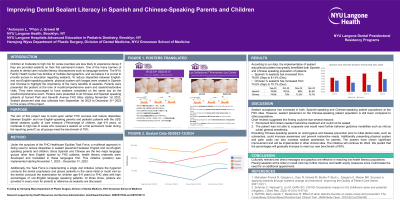Preventive
Improving Dental Sealant Literacy in Spanish- and Chinese-Speaking Parents and Children *Aslanyan L, *Phan J, Grewal M NYU Langone Health, Brooklyn, NY
302 - Improving Dental Sealant Literacy in Spanish- and Chinese-Speaking Parents and Children

- JP
Julian H. Phan, DMD (she/her/hers)
Resident
NYU Langone Dental Medicine, Brooklyn, NY
Brooklyn, New York, United States - LA
Liana Aslanyan, DDS
NYU Langone Health Brooklyn
- MG
Meeta Grewal, DDS
Research Mentor
NYU Langone Brooklyn
Brooklyn, New York, United States - DK
Daniel J. Kane, DMD
Program Director
NYU Langone Dental Medicine, Brooklyn, NY
Brooklyn, New York, United States
Presenting Author(s)
Co-Author(s)
Research Mentor(s)
Program Director(s)
Purpose: The aim of this project is to build upon earlier FHC success and reduce disparities between English- and non-English-speaking parents and pediatric patients with the UDS dental sealants quality of care measure (“Percentage of children, age 6-9 years, at moderate to high risk of caries who received a sealant on a first permanent molar during the reporting period”) so all groups meet the benchmark of 78% .
Methods: Under the auspices of the FHC Healthcare Equities Task Force, a multilevel approach is being used to reduce disparities in sealant placement between English and non-English speaking parents and patients. Since Spanish and Chinese are the two major language groups other than English spoken by FHC patients, health literacy materials were developed in these languages first. A literature review was conducted through the NYU Health Sciences Library to explore for guidance on approaches to reach non-English speaking parents and children regarding oral health information.
Results: Direct messages and graphics in patient-preferred language are effective in reaching low health literacy populations. Posters have been designed by the authors and translated into Spanish and Chinese to be utilized by the parents of pediatric patients to evaluate their effectiveness.
Conclusion: Presenting parents with graphics and posters regarding sealants are very favorable in instances where there is a language barrier. Completing sealant placement at the initial or recall visit may improve oral health equity. We plan to leverage initiatives currently underway at FHC, including motivational interviewing to encourage parents and pediatric patients’ positive behavioral changes.
Identify Supporting Agency and Grant Number:
Research supported by Health Resources and Services Administration, Grant/Award Numbers: D88HP37549 and D87HP46111

.jpg)